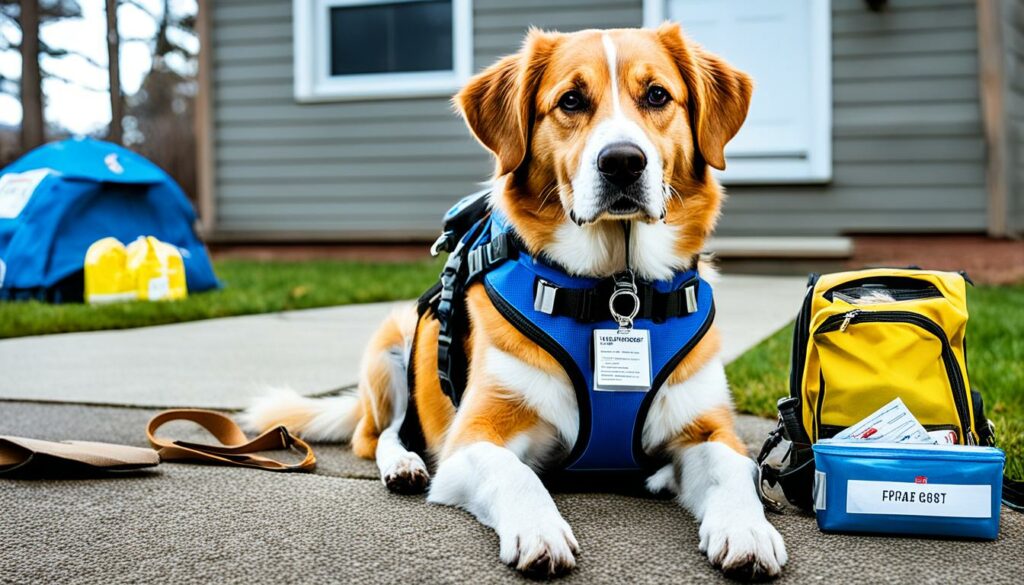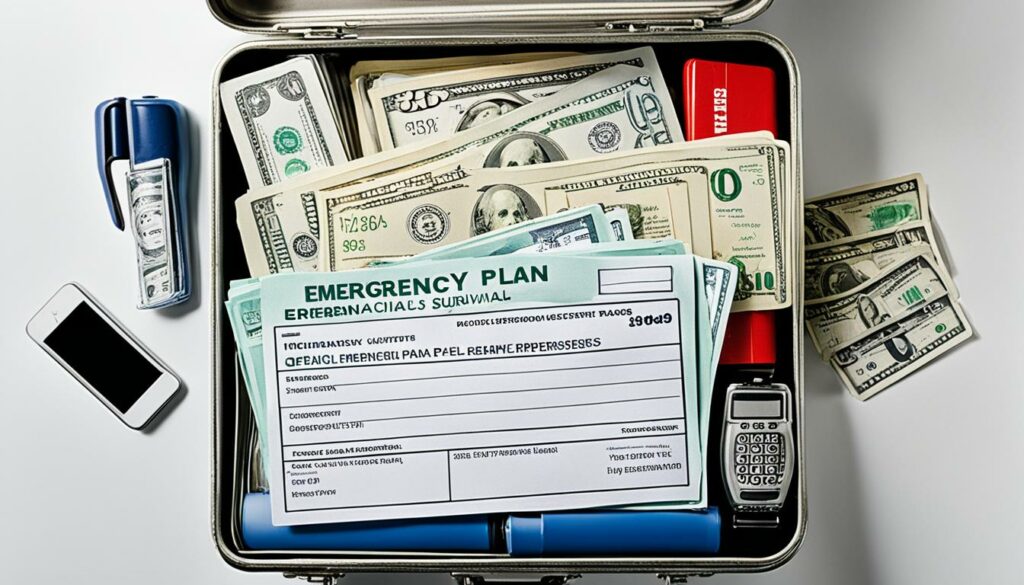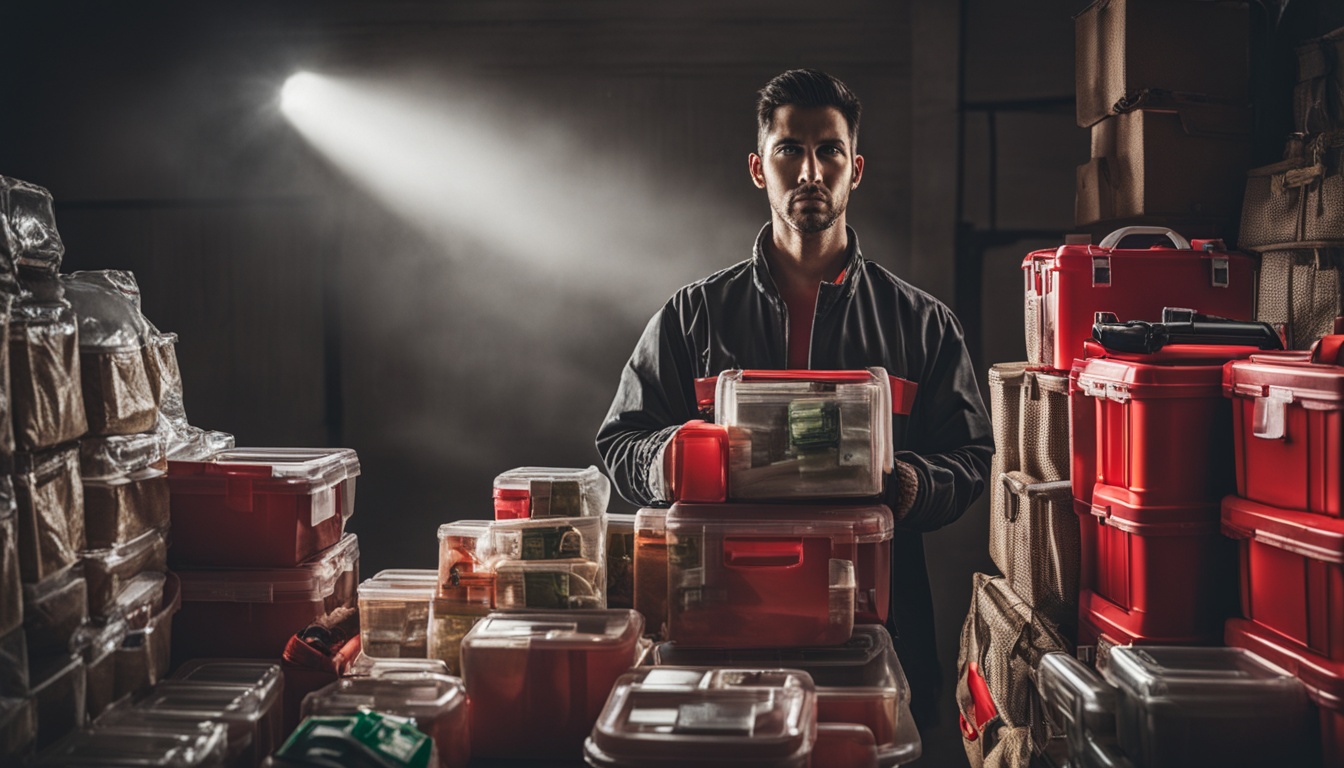In our unpredictable world, having an emergency survival plan is key. It keeps you and your loved ones safe in disasters and emergencies. This guide will give you the knowledge and tools to make a plan for your family’s needs.
By following these steps, you’ll be ready for many crises. This includes natural disasters and man-made emergencies.
Key Takeaways
- Creating an effective emergency survival plan is essential for crisis preparedness.
- Understanding common emergencies and natural disasters can help you anticipate and mitigate risks.
- Assembling a comprehensive emergency survival kit with essential supplies is a critical component of your plan.
- Protecting your home and property, as well as preparing for financial emergencies, are crucial steps.
- Special considerations for families, such as planning for children and seniors, must be addressed.
Introduction
Emergencies and natural disasters can happen fast, with little warning. Being prepared keeps you and your family safe. This part talks about why you need an emergency preparedness plan. It also covers the usual natural disasters and crises you might face.
The Importance of Being Prepared
In today’s world, disaster planning is a must. A good emergency survival plan helps lessen the effects of natural disasters and emergencies. It can change chaos to calm, survival to safety.
Common Emergencies and Natural Disasters
There are many natural disasters like hurricanes, floods, earthquakes, and power outages. Knowing the risks in your area helps you prepare. This way, your family is ready for any challenge.
“Disaster preparation is not just about survival – it’s about empowering yourself and your loved ones to weather any storm.”
Creating an Emergency Survival Plan
Start making a emergency survival plan by thinking about what your family needs. This is key to making sure your plan fits everyone, like kids, older family members, or those with special health needs.
Assessing Your Family’s Needs
Take time to look at your family’s situation. Think about things like:
- The ages and health of your family members
- Any special needs or mobility issues
- The presence of pets or service animals
- Your family’s access to transportation and communication devices
Knowing what your family needs helps you make a emergency survival plan that’s right for them. This plan will give the support and resources needed in a crisis.
Establishing Communication and Meeting Points
Good communication strategies and meeting spots are key to a strong family emergency plan. Make sure your plan includes:
- A communication plan for staying in touch during emergencies, with backup methods if needed.
- Meeting places in your area and outside, for finding each other if you get separated.
Talking about and practicing your plan makes your family ready. It helps them know how to use communication strategies and find each other in an emergency.
| Importance of Communication and Meeting Points | Benefits |
|---|---|
| Ensures your family can stay connected | Reduces stress and confusion during an emergency |
| Provides a clear plan for reuniting | Increases the likelihood of a successful reunion |
| Builds confidence and preparedness | Empowers your family to respond effectively |
“Preparedness is the key to survival. By creating a comprehensive emergency plan, you’re not only protecting your loved ones, but also empowering them to navigate through challenging situations with confidence and resilience.”
Building an Emergency Survival Kit
Getting ready for emergencies is key. A good emergency survival kit is a must for safety. This guide will show you how to pack the right items for your family’s safety.
Water and Food Supplies
Start with a good water supply in your kit. You’ll need at least one gallon of water for each person each day. Think about getting water purification tablets or a portable filter for clean water.
Don’t forget non-perishable food like canned goods, dried fruits, nuts, and energy bars. Make sure to check your food often to keep it fresh.
First Aid and Hygiene Essentials
A first aid kit is a must for emergencies. Pack bandages, antiseptic wipes, pain relievers, and any needed medicines. Also, include soap, toothpaste, toilet paper, and feminine products for staying clean and healthy.
- Bandages and antiseptic wipes
- Pain relievers and prescription medications
- Soap, toothpaste, and other personal hygiene items
Building an emergency kit is an ongoing task. Always check and update it to keep it ready for emergencies.
“Preparation is the key to survival. Build your emergency kit today, and be ready for whatever comes your way.”
Emergency Preparedness for Pets and Service Animals
Pets and service animals are key members of many families. We must keep them safe in any emergency plan. Making sure they are ready for emergencies helps keep them safe and sound.
Make a special emergency kit for your pets. Put in food, water, medicine, leashes, and carriers. Also, find safe places to go with your pets and make plans for their care if you can’t stay home.
Service animals like guide dogs need extra care too. Make sure their emergency kit has all they need, like equipment and medicine. Also, know the rules at local shelters so they can be with you.
Planning for your pets and service animals means they’ll get the care they need in an emergency. Their safety is as important as yours. Including them in your plans gives you peace of mind when it’s needed most.

“The greatness of a nation can be judged by the way its animals are treated.”
– Mahatma Gandhi
Home and Property Protection
When emergencies or natural disasters hit, keeping your home safe is key. By being proactive, you can protect your home and keep your family safe.
Securing Your Home Before a Disaster
Start by checking your home’s outside for weak spots. Cut back trees and plants that could harm your windows or roof. Use strong windows and doors, and add hurricane straps to your home.
Also, have a backup power plan. This could be a generator or solar panels. They keep your home running during a power cut.
Evacuation Routes and Shelters
Learn the best ways to leave your area quickly. Make sure these paths are clear. Find out where emergency shelters are, like schools or community centers.
Know what each shelter offers and if they have limits. This helps you plan for safety if you need to go there.
By focusing on home and property protection, securing your home, and knowing evacuation routes and shelters, you’re ready for emergencies. This keeps your family and things safe.
Financial Preparedness
Being ready financially is as important as being ready physically in an emergency. Having emergency cash and important documents ready can really help. This part talks about how to keep your money safe during a crisis.
Emergency Cash and Important Documents
First, save some emergency cash. You should have $500 to $1,000 in small bills and coins. Keep it in a safe spot at home. This cash is very useful if you can’t use ATMs or banks during a disaster.
Also, keep your important papers safe. This includes things like your driver’s license, birth certificates, and Social Security cards. Keep copies in a safe box and also save them online in a secure place.
- Gather all essential documents in a portable container
- Make copies of important documents and store them separately
- Digitize documents and upload them to a secure cloud storage service
- Ensure you have immediate access to your financial preparedness kit
Building a good financial preparedness plan gives you peace of mind. You’ll know your money is safe when you need it most in an emergency.

“Being financially prepared for an emergency can bring peace of mind and help you weather the storm more effectively.”
Special Considerations for Families
Emergency planning is key for families with kids, elderly, or those with disabilities. These groups have special needs for safety and well-being in a crisis.
Planning for Children and Seniors
For families with kids, making sure they’re safe is a top priority. This means packing diapers, formula, and snacks for little ones. For seniors, it’s important to have their meds and equipment ready.
It’s also key to think about their needs for moving around and thinking clearly.
Accommodating Disabilities and Medical Needs
People with disabilities or health issues need special plans too. This might mean having backup power for medical devices or packing special gear. It’s also smart to talk to doctors to understand what you need to do.
| Considerations for Vulnerable Populations | Recommended Actions |
|---|---|
| Children |
|
| Seniors |
|
| Individuals with Disabilities or Medical Conditions |
|
By focusing on the needs of kids, seniors, and those with disabilities, families can make a strong emergency plan. This way, everyone stays safe and cared for.
Staying Informed and Connected
In emergencies, having clear and reliable ways to communicate is key. Using battery-powered or hand-crank radios can be a big help. They let you get important news and updates even when other ways to communicate fail.
Emergency Communication Devices and Radios
Emergency communication devices, like portable radios, keep you in the loop. They give you news and alerts from local authorities. These devices work even when there’s no power, so you can stay connected during outages or when cell networks are down.
Adding emergency radios to your emergency kit means you can keep up with the latest news. You’ll get advice on what to do next and can check in with your family. This helps keep everyone safe and well.
FAQ
Why is having an emergency survival plan crucial?
What are the most common types of emergencies and natural disasters to prepare for?
How do I develop a comprehensive emergency survival plan?
What should I include in my emergency survival kit?
How do I prepare for emergencies with my pets and service animals?
What can I do to protect my home and property during an emergency?
How do I ensure my family’s financial preparedness for an emergency?
How do I address the unique needs of vulnerable populations in my emergency plan?
What are the best ways to maintain communication during an emergency?
Source Links
- Build A Kit | Ready.gov – https://www.ready.gov/kit
- Survival Kit Supplies – https://www.redcross.org/get-help/how-to-prepare-for-emergencies/survival-kit-supplies.html
- Make A Plan | Ready.gov – https://www.ready.gov/plan
